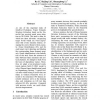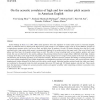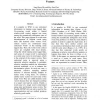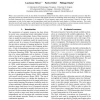COLING
2010
13 years 4 months ago
2010
As one of the important tasks of SemEval Evaluation, Frame Semantic Structure Extraction based on the FrameNet has received much more attention in NLP field. This task is often di...
COLING
2010
13 years 4 months ago
2010
We show that unsupervised part of speech tagging performance can be significantly improved using likely substitutes for target words given by a statistical language model. We choo...
COLING
2010
13 years 4 months ago
2010
Word Sense Disambiguation (WSD) often relies on a context model or vector constructed from the words that co-occur with the target word within the same text windows. In most cases...
SPEECH
2010
13 years 7 months ago
2010
Earlier findings in Shue et al. (2007, 2008) raised questions about the alignment of nuclear pitch accents in American English, which are addressed here by eliciting both high an...
COLING
2002
13 years 9 months ago
2002
It is popular in WSD to use contextual information in training sense tagged data. Co-occurring words within a limited window-sized context support one sense among the semantically...
NAACL
2003
13 years 10 months ago
2003
Manually constructing an inventory of word senses has suffered from problems including high cost, arbitrary assignment of meaning to words, and mismatch to domains. To overcome th...
NAACL
2003
13 years 10 months ago
2003
This paper presents an unsupervised method for discriminating among the senses of a given target word based on the context in which it occurs. Instances of a word that occur in si...
LREC
2008
13 years 10 months ago
2008
When a user cannot find a word, he may think of semantically related words that could be used into an automatic process to help him. This paper presents an evaluation of lexical r...
LREC
2008
2008
Division of Example Sentences Based on the Meaning of a Target Word Using Semi-Supervised Clustering
13 years 10 months ago
In this paper, we describe a system that divides example sentences (data set) into clusters, based on the meaning of the target word, using a semi-supervised clustering technique....
LREC
2008
13 years 10 months ago
2008
In this paper we analyse data from the SemEval lexical substitution task in those cases where the annotators indicated that the target word was part of a phrase before substitutin...




